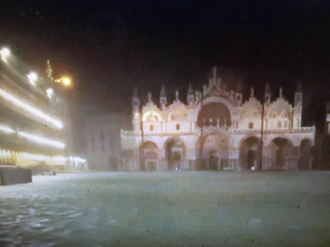Venice: St Mark's Cathedral engulfed by worst flood in 50 years

St Mark's Square is waist-deep in water tonight.
St Mark's Cathedral in Venice was inundated with floodwater late on Tuesday night. The historic church, which dates back to 1092, was swamped with water following the city's highest tide in 50 years which raised water levels by around six feet.
As strong winds whipped up the waves on the famous square, it transformed into a lake. Waters surged into the Basilica with a force "never seen before." Local authorities in the Italian lagoon city have called for a state of emergency to be declared.
At least 70 percent of Venice was under water on Wednesday, inundating the city's famous canals, squares, houses, shops as well as the 11th-century Basilica.
Gondolas and water taxis have been destroyed, boats broken free from their moorings, with tables and chairs from street cafes floating in the waters. At least two lives have been claimed by the floods.
"We're talking about millions of euros worth of damage," said Carlo Alberto Tesserin, First Procurator of the Basilica, who is the president of a team responsible for managing the historic site. "We said last year that the Basilica aged 20 years in a high tide and it risks having aged much more than that in this one," he added. St Mark's is particularly at risk, sitting as it does in one of the lowest lying parts of the city. "The damage we see now is nothing compared to that within the walls for the salt enters the marble, the bricks, everywhere", Tesserin lamented.
The Mayor of the city, Luigi Brugnaro, tweeted: "Venice is on its knees. St Mark's Basilica has suffered serious damage, as have the whole city and the islands." He blamed climate change for the unusually high tides, and said the tide was, "a wound that will leave a permanent mark."
This is only the sixth time that St Mark's Basilica - which has seen music performances from the likes of great Baroque composers Vivaldi, Monteverdi and Gabrieli - has been flooded in its history. People worked through the night on Tuesday to clear sewage water from the historic mosaics adorning the floor of the building, situated in St Mark's Square. Dirty water swirled around marble tombs inside the 12th century crypt, and pumps were in action to clear seawater from around the altar and under the pink and white stone arches. The historic monument's custodians looked on in shock and distress.
Thousands of tourists flock to the Italo-Byzantine monument every day, gazing up at the shimmering gold ground mosaics that decorate its majestic domes or pausing in front of the venerated tomb of St Mark. Over the last few days tourists in Venice have shared photos and videos on social media showing people wading through St Mark's Square. Italy's culture minister Dario Franceschini has said the government will provide funding to help preserve the site in the UNESCO city. "The experts gave us ample warning, but they weren't listened to," Tesserin said.
The city stands on wooden piles driven into the mud, but rising sea levels and heavy cruise ship traffic have eaten away at the surrounding marshes and mudbanks and left Venice more vulnerable to the whims of the Adriatic sea.
Construction of the planned flood barriers, a massive infrastructure project called MOSE, has been underway since 2003 to protect Venice, but it has long been plagued by cost overruns, corruption scandals and delays. Tesserin said climate change and Venice's subsidence problems mean that the city needs to be told immediately if it is likely to work or "we need another plan." As he spoke civil protection workers checked the crypt for structural damage. "It's a religious, cultural and artistic symbol, and it's unique," he added; "there's another high tide tonight, and more forecast for the coming days, for Venice to survive we need to act now."
Watch a short clip from Greenpeace Italia's Twitter feed tonight: https://twitter.com/greenpeace_ita/status/1194640506766143490?s=12


















